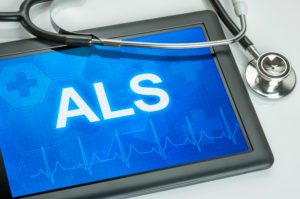May is ALS Awareness Month

Besides being the month we set aside to honor mothers, May is also ALS Awareness Month. Also known as Lou Gehrig’s Disease (named after the high-profile baseball player who was diagnosed with the disease), amyotrophic lateral sclerosis (ALS) is a devastating progressive neurodegenerative disease that affects nerve cells in the brain and spinal cord.
The Greek word “amyotrophic” breaks down into “a” (meaning “no”), “myo” (meaning “muscle,”) and “trophic” (meaning “nourishment”). In essence, “amyotrophic” means “no muscle nourishment.” “Lateral” refers to the areas in the spinal cord where portions of the nerve cells that signal and control the muscles are located. “Sclerosis” means “hardening” or “scarring,” which happens to the lateral region as the area degenerates.
Motor neurons reach from the brain to the spinal cord, and then to the muscles throughout the body. Those with ALS experience both upper motor neuron degeneration in the brain, causing spasticity (muscle tightness), as well as lower motor neuron degeneration in the spinal cord and brainstem, leading to muscular weakness, atrophy, and twitching. As motor neurons begin to die, the ability of the brain to initiate and control voluntary muscle movement is lost. As muscles begin to atrophy or waste away, a person’s ability to speak, swallow, breathe, and walk is gradually impacted, negatively affecting every aspect of his or her life.
Sporadic ALS, which may affect anyone, anywhere, at any time, accounts for up to 95% of all cases. Familial ALS (known as FALS), which means the disease is inherited, accounts for 5-10% of all cases. In those families affected, there is a 50% chance each new child will inherit the gene mutation and possibly go on to develop the disease. ALS is relatively rare, with only about 6,000 people diagnosed in the United States each year.
While the causes of ALS are not known for sure, multiple complex factors typically combine to contribute to the death of motor neurons. People with ALS generally have higher-than-normal levels of glutamate, a chemical messenger in the brain and in the spinal fluid around nerve cells. High levels of glutamate are toxic to some nerve cells and may cause ALS. An overactive immune response can also cause a person’s immune system to begin to attack healthy cells, leading to the death of nerve cells. Additionally, the inability of a protein system to repair nerve cells that tell the muscles what to do can lead to ALS. Free radical injury, mitochondrial dysfunction, and programmed cell death are also often contributing causes.
Most people are diagnosed with ALS between the ages of 40 and 70, with 55 being the average age of onset. Earlier cases in people who are in their twenties and thirties have also been reported, however, including well-known individuals like Stephen Hawking and Lou Gehrig.
The onset of ALS involves muscle weakness or stiffness as the earliest detected symptoms. One person may suddenly have trouble lifting a coffee mug, while another may experience a change in vocal pitch while speaking. The muscular weakness gets progressively more severe, resulting in paralysis of the muscles of the limbs and trunk, as well as the muscles that control speech, swallowing, and breathing. The speed and order of symptom progression differs from person to person. Since ALS only attacks motor neurons, the senses of sight, touch, hearing, touch, and smell are not affected. For many people, muscles of the eyes and bladder are also not affected.
The average survival time is three years from diagnosis, but about 20% of those with ALS live five years, while 10% survive 10 years and 5% live 20 years or longer. (Astrophysicist Stephen Hawking notably lived for 55 years after his ALS diagnosis!) Progression is not always in a straight line. Weeks or months can go by where there is little new loss of function, and occasionally an individual even experiences a reversal and some recovery of lost function. These encouraging signs are almost always transient, however.
ALS is a difficult disease to diagnose because it mimics several other neurological diseases, most of which are treatable. There is no one test or procedure used to diagnose ALS. It is only detected through a clinical examination and a comprehensive diagnostic workup that includes a spinal tap, muscle and/or nerve biopsy, blood and urine studies, x-rays, myelogram of cervical spine, and a thorough neurological examination. Research for a cure is ongoing, and there are only a few effective treatments. The U.S. FDA has currently approved four drugs (Riluzole, Nuedexta, Radicava, and Tiglutik) to treat ALS.
If you know or care for someone suffering from ALS, be sure they know they may experience a better qualify of life in living with the disease by participating in local support groups and by attending an ALS Association Certified Treatment Center of Excellence or a Recognized Treatment Center. These kinds of centers provide best-practice multidisciplinary care to help manage the symptoms of the disease, enabling those living with ALS to maintain as much independence as possible for as long as possible. Therapies and interventions include proper body positioning, exercise regimens, customized wheelchairs, technological devices that help people to communicate, feeding tubes, diaphragm pacers, breathing devices, and easy-to-swallow foods and liquids.
Many people with ALS decide to take part in research studies to help test new medications aimed at treating the disease. To learn more about these studies, visit the U.S. National Institutes of Health Clinical Trials Registry. For more information about this devastating disease, visit www.als.org.
